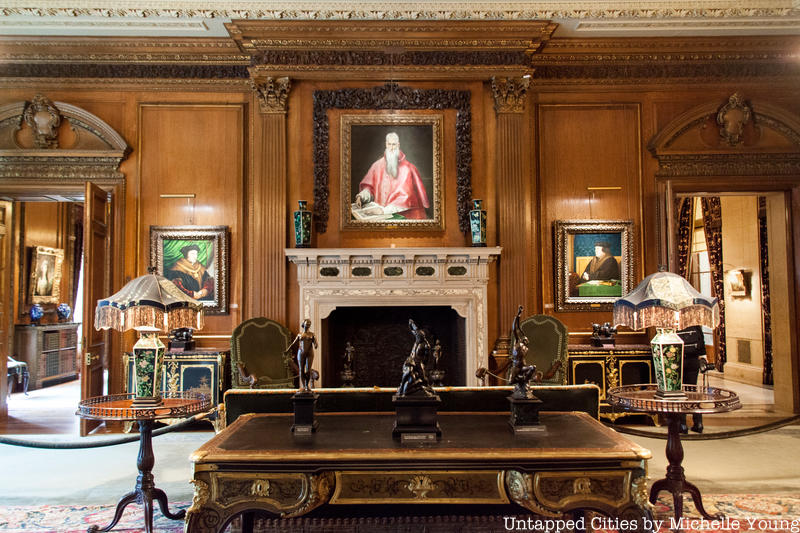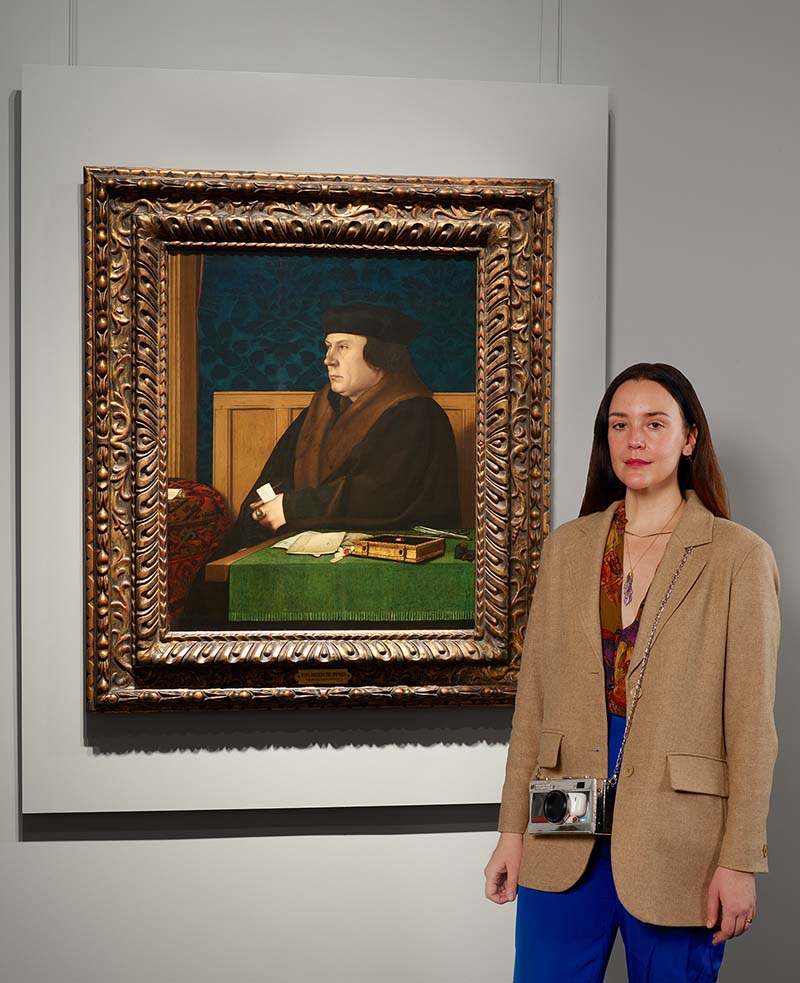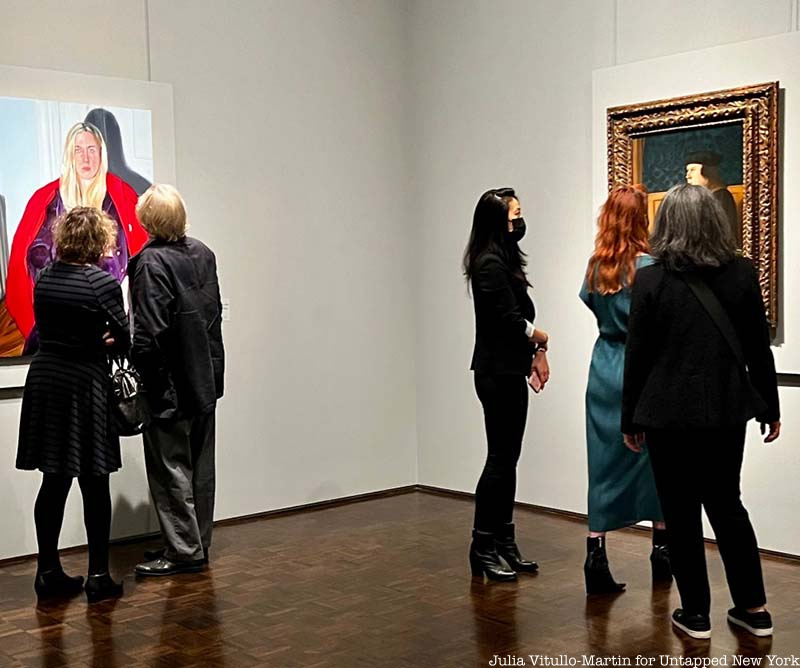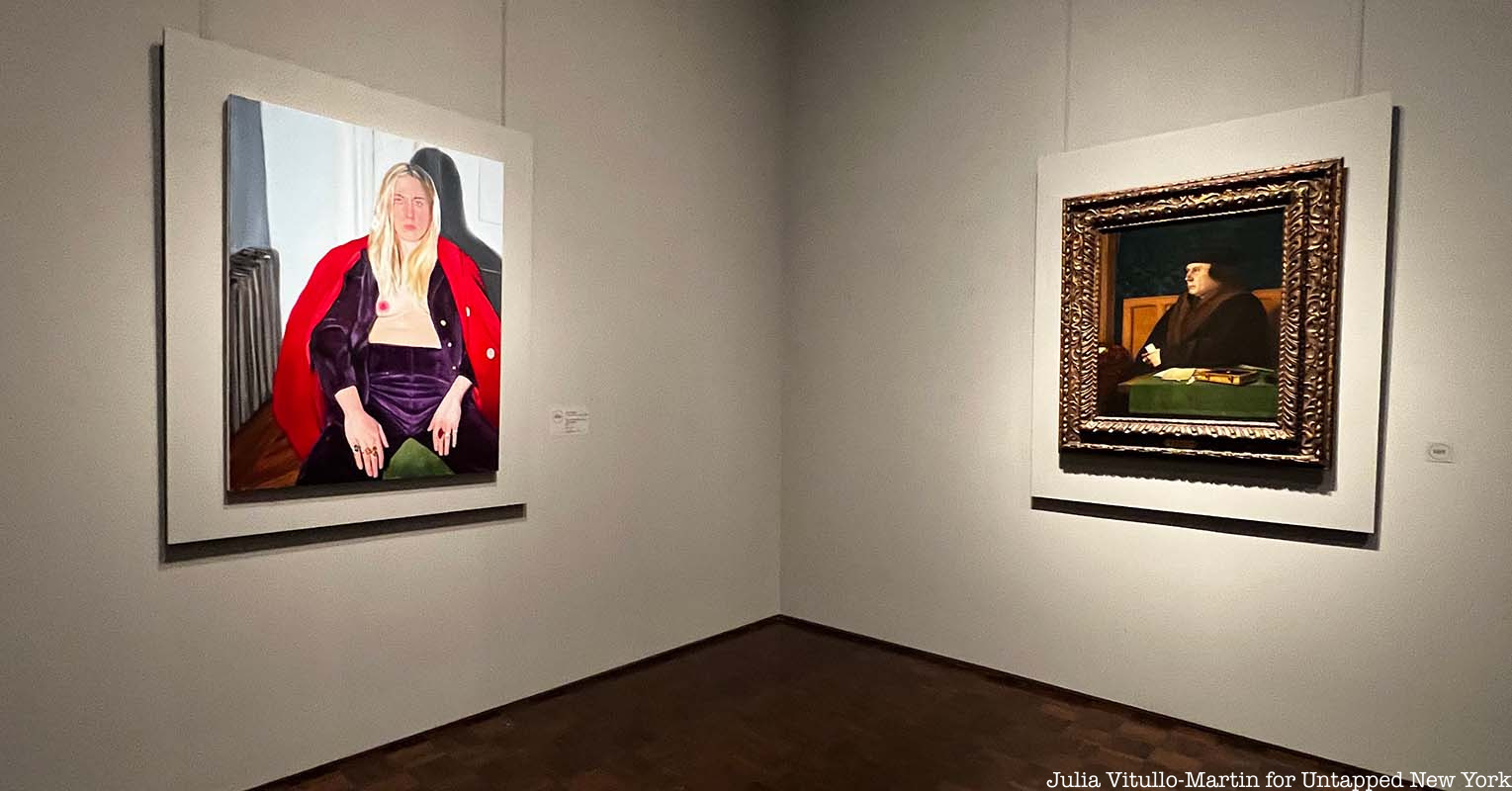It’s a shock, as it’s intended to be: Where Hans Holbein the Younger’s portrait of Sir Thomas More, serene in his velvet robes, once stood, there is now Jenna Gribbon’s painting of a half-undressed, long-haired person of ambiguous gender, stylish hands on knees, legs apart, staring ahead implacably. What remains on the adjacent wall of the Frick Madison is Holbein’s Thomas Cromwell, low-browed and sullen, surely wondering about his new protagonist. His expression can’t change, can it? But he seems to grow more morose, sinking into his luxurious fur collar and clutching his official paper a little more desperately.
It had been Henry Clay Frick himself who had paired the two ancient enemies, placing More and Cromwell on opposite sides of the fireplace mantel in the living hall of his luxurious Beaux-Arts mansion on the Upper East Side.
Frick’s friend, the painter Charles Ricketts, summarized the scene in 1919: “Imagine Sir Thomas More, the beautiful saint, and [Thomas] Cromwell, the monster, united in history, art, and tragedy, now facing each other, united by Holbein and time and chance.”

Now they have been split asunder by a daring new program at the Frick Madison, Living Histories: Queer Views and Old Masters, which seeks to bring fresh perspectives to the Masters, particularly emphasizing issues of gender and queer identity generally excluded from narratives of early modern European art. Each chosen contemporary artist “presents a single new work in conversation with iconic paintings in the Frick’s collection.”
What Am I Doing Here?
Gribbon’s painting, entitled “What Am I Doing Here? I Should Ask You the Same,” throws down a gauntlet. Surely no one ever questioned the presence of Holbein’s Cromwell or his More at the Frick. But many patrons are likely to doubt, rightly or wrongly, the replacement of a Holbein by a Gribbon. And just as Gribbon’s subject, her partner Mackenzie Scott, confronts the patron directly, so Gribbon boldly defies doubters: What are you doing here? What right do you have to wander freely among this magnificent art? It’s a sort of Goldilocks situation—except Goldilocks/Gribbon counterintuitively contests Papa Bear’s right to challenge her. An intellectual hornet’s nest suitable to the animosity between More and Cromwell—and perhaps the animosity between contemporary art and Old Masters that the Frick Madison is trying to mitigate.

Intimidating Cromwell
In a conversation with Deputy Director Xavier F. Salomon, Gribbon said she grew up in East Tennessee, dreaming of coming to New York “because of a notion that art existed here, and it didn’t really exist around me in Tennessee.” And while it is “mind-blowing” now for her to even consider the possibility of her work being in a room with Holbein’s, on being given the assignment she carefully painted a bold, queer woman capable of “really intimidating Cromwell.” That’s only right, she notes, because there should be “a sense of rivalry in terms of the relationship to Cromwell if she is the replacement for Sir Thomas More.”
Speaking of relationships to Cromwell, a historian might speculate that Gribbon’s Mackenzie is a suitable replacement for Anne Boleyn, Henry VIII’s second wife, whose downfall and execution were orchestrated by Cromwell. A woman of extraordinary talent and strength, Boleyn would surely relish being painted large and defiantly installed opposite her bitter enemy. But there is, of course, no Holbein portrait of Boleyn, which reinforces Salomon’s point about the dearth of strong women in Western art as well as the Frick’s thinking behind Living Histories. The Holbein room, he says, generates “that incredible male power, two men staring at one another, both painted by another man. What I find really powerful now is that you have this man painted by a man, matched with a woman, a very powerful woman, painted by another woman.”
The world has changed.
Missing Sir Thomas More
Frick Madison Curator Aimee Ng, who jointly organized Living Histories with Salomon, says that Gribbon’s “ideas for her composition started from zero, concentrating on the missing Thomas More.” Only fair since Holbein’s More is ranked as the greatest Holbein in America, says Salomon, and a superior portrait to that of Cromwell.
Gribbon thought long and hard about the portrait of More before conceiving of his replacement. So many elements of the More portrait are striking, but especially the clothes and the symbols of status. More is wearing a chain that indicates his high office and a fabulous fur-lined coat of rich fabrics, black satin, and red velvet. Ng says that the velvet helped lead Gribbon to an “exuberant aesthetic of camp, which has always been a part of queer history.”
More’s power and social status, as depicted so convincingly by Holbein, signals his right to be featured in the painting, says Gribbon. But what about the right of the many women like Anne Boleyn, who because of their gender were never accorded sufficient power or social status to be painted by Holbein? That’s where Gribbon comes in, giving Mackenzie “not just one or two kinds of velvet, but three, and not just one opulent ring, but six,” Gribbon makes the power play of portraiture very obvious, says Ng. After all, the vast majority of Old Master portraits are about power. And in the world of power placid, demure women don’t fit, except as partners or lesser beings, beautiful women painted by men.

Seeing People
“I’m always interested in the way that people are seen versus the way that they think they are or the way they want to be,” Gribbon told Cultured. “Because my partner is a public figure, it ends up also being about public versus private, how she’s depicted outside of our home versus inside of our home and what those two things look like next to each other.” As men, up until their public beheadings, More and Cromwell were among the most powerful men in England.
More, beloved by Holbein—parallel to Mackenzie, beloved by Gribbon—was generously painted. Every detail speaks to his superior status and character. His expression is serene. The gold S-S chain, in the painting’s dead center, was an emblem of service to the king. The letters stand for the motto, Souvent me souvien, or, Think of me often. More’s elegantly soft hands show that this is a man free of physical labor. Cromwell, on the other hand, looks like a thug. Novelist Hillary Mantel has Cromwell say, “I look like a murderer,” to which his son replies, “Didn’t you know?”
Clothed in passionate red and royal purple, hands be-ringed but otherwise without jewelry, one neon-pink breast exposed, Mackenzie is formidable. No one messes with this woman, not even Cromwell, destroyer of lives.
Living Histories
The Frick Madison’s year-long Living Histories project featuring the work of four New York-based artists—Doron Langberg, Salman Toor, Jenna Gribbon, and Toyin Ojih Odutola—will run through September 11, 2022. Salomon points out that like so many of the Frick’s staff and the museum’s founder, Henry Clay Frick, the four artists are not originally from New York. Yet all chose this city as a home for their careers and relationships.
The project is a celebration of the past and present but also a tribute to New York City, home to art, controversy, and the four artists.
Julia Vitullo-Martin can be reached at @JuliaManhattan.






